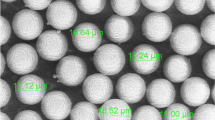Abstract
Porous BiScO3–0.64PbTiO3 (0.36BS–0.64PT) ceramics were fabricated by using burnable plastic sphere technique. Self-synthesized polystyrene microsphere (PS, φ0.36 μm) and poly methyl methacrylate (PMMA, φ2, 10 and 18 μm) micro-balls were selected as PFA. The porosity, microstructure and electrical properties were investigated for porous 0.36BS–0.64PT ceramics fabricated with different particle sizes of pore forming agents (PFA). With increasing particle sizes of PFA, the pore size and porosity increased. Meanwhile relative permittivity (ε r), piezoelectric coefficient (d 33, −d 31) and electromechanical coupling coefficients (k p, k t) decreased. The mechanical quality factor (Q m), elastic coefficient (s 11), hydrostatic voltage coefficient (g h) and hydrostatic figure of merit increased accordingly. Finally, the effects of particle sizes of PFA on the microstructure and electrical properties were discussed.







Similar content being viewed by others
References
E. Mercadelli, A. Sanson, C. Galassi, in Porous Piezoelectric Ceramics, ed. by E. Suaste-Gomez (INTECH, Rijeka, 2010) pp. 111–128
C. Paolo, Engineering porosity in polymer-derived ceramics. J. Eur. Ceram. Soc. 28, 1389–1395 (2008)
C.R. Bowen, A. Perry, A.C.F. Lewis, H. Kara, Processing and properties of porous piezoelectric materials with high hydrostatic figures of merit. J. Eur. Ceram. Soc. 24, 541–545 (2004)
H.L. Zhang, J.F. Li, B.P. Zhang, Microstructure and electrical properties of porous PZT ceramics derived from different pore-forming agents. Acta Mater. 55, 171–181 (2007)
A.K. Yang, C.A. Wang, R. Guo, Y. Huang, Microstructure and electrical properties of porous PZT ceramics fabricated by different methods. J. Am. Ceram. Soc. 93, 1984–1990 (2010)
T. Zeng, X.L. Dong, S. T. Chen, and H. Yang, Processing and piezoelectric properties of porous PZT ceramics. Ceram. Int. 33, 395–399 (2007)
B.P. Kumar, H.H. Kumar, D.K. Kharat, Effect of porosity on dielectric properties and microstructure of porous PZT ceramics. Mater. Sci. Eng. B 127, 130–133 (2006)
T. Zeng, X.L. Dong, H. Chen, Y.L. Wang, The effects of sintering behavior on piezoelectric properties of porous PZT ceramics for hydrophone application. Mater. Sci. Eng. B 131, 181–185 (2006)
S.H. Lee, S.H. Jun, H.E. Kim, Piezoelectric properties of PZT-based ceramic with highly aligned pores. J. Am. Ceram. Soc. 91, 1912–1915 (2008)
A.K. Yang, C.A. Wang, R. Guo, Y. Huang, C.W. Nan, Effects of porosity on dielectric and piezoelectric properties of porous lead zirconate titanate ceramics. Appl. Phys. Lett. 98, 152904 (2011)
S.B. Lang, E, Ringgaard, Measurements of the thermal, dielectric, piezoelectric, pyroelectric and elastic properties of porous PZT samples. Appl. Phys. A 107, 631–638 (2012)
I. Chilibon, J.N. Marat-Mendes, Ferroelectric ceramics by sol–gel methods and applications: a review. J Sol-Gel. Sci. Technol. 64, 571–611 (2012)
S. Iyer, T.A. Venkatesh, Electromechanical response of porous piezoelectric materials: effects of porosity connectivity. Appl. Phys. Lett. 97, 072904 (2010)
B.P. kumar, H.H. Kumar, D.K. kharat, Study on microstructure, piezoelectric and dielectric properties of 3–3 porous PZT composites. J. Mater. Sci. 17, 515–518 (2006)
T. Zeng, X.L. Dong, C.L. Mao, Z.Y. Zhou, H. Yang, Effects of pore shape and porosity on the properties of porous PZT 95/5 ceramics. J. Euro. Ceram. Soc. 27, 2025–2029 (2007)
R. Guo, C.A. Wang, A.k.. Yang, Piezoelectric properties of the 1–3 type porous lead zirconate titanate ceramics. J. Am. Ceram. Soc. 94, 1794–1799 (2011)
B.P. Kumar, H.H. Kumar, D.K. Kharat, Study on pore-forming agents in processing of porous piezoceramics. J. Mater. Sci. 16, 681–686 (2005)
R.E. Eitel, S.J. Zhang, T.R. Shrout, C.A. Randall, Phase diagram of the perovskite system (1−x) BiScO3−xPbTiO3. J. Appl. Phys. 96, 2828–2831 (2004)
J.T. Tan, Z.R. Li, Microstructures, dielectric and piezoelectric properties of unannealed and annealed porous 0.36BiScO3–0.64PbTiO3 ceramics. J. Mater. Sci. 51, 5092–5103 (2016)
J.T. Tan, Z.R. Li, Fabrication and electrical properties of porous BS–0.64PT high temperature piezoceramics using polystyrene microsphere. Ceram. Int. 41, S414–S420 (2015)
A.K. Yang, C.A. Wang, R. Guo, Y. Huang, C.W. Nan, Effects of sintering behavior on microstructure and piezoelectric. Ceram. Int. 36, 549–554 (2010)
A.N. Rybyanets, Porous piezoceramics: theory, technology, and properties. IEEE Trans. Ultrason. Ferroelectr. Freq. Control 58, 1492–1507 (2011)
Y. Huan, X.H. Wang, J. Fang, L.T. Li, Grain size effect on piezoelectric and ferroelectric properties of BaTiO3 ceramics. J. Eur. Ceram. Soc. 34, 1445–1448 (2014)
Acknowledgements
The SEM work was done at International Center for Dielectric Research (ICDR), Xi’an Jiaotong University, Xi’an, China. This work was financially supported by the 111 project (B14040), International Science & Technology Cooperation Program of China (Grant Nos. 2014DFR51240 and 2013DFR50470) and Science and technology research and development program of Shaanxi province (Grant No. 2014KW08-01).
Author information
Authors and Affiliations
Corresponding author
Rights and permissions
About this article
Cite this article
Tan, J., Li, Z. Effects of pore sizes on the electrical properties for porous 0.36BS–0.64PT ceramics. J Mater Sci: Mater Electron 28, 9309–9315 (2017). https://doi.org/10.1007/s10854-017-6668-1
Received:
Accepted:
Published:
Issue Date:
DOI: https://doi.org/10.1007/s10854-017-6668-1




